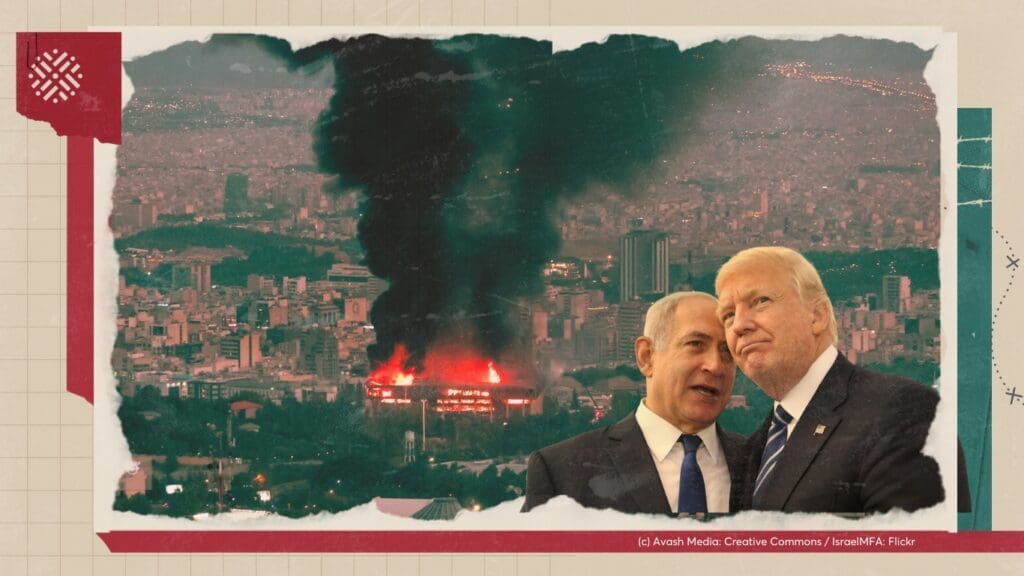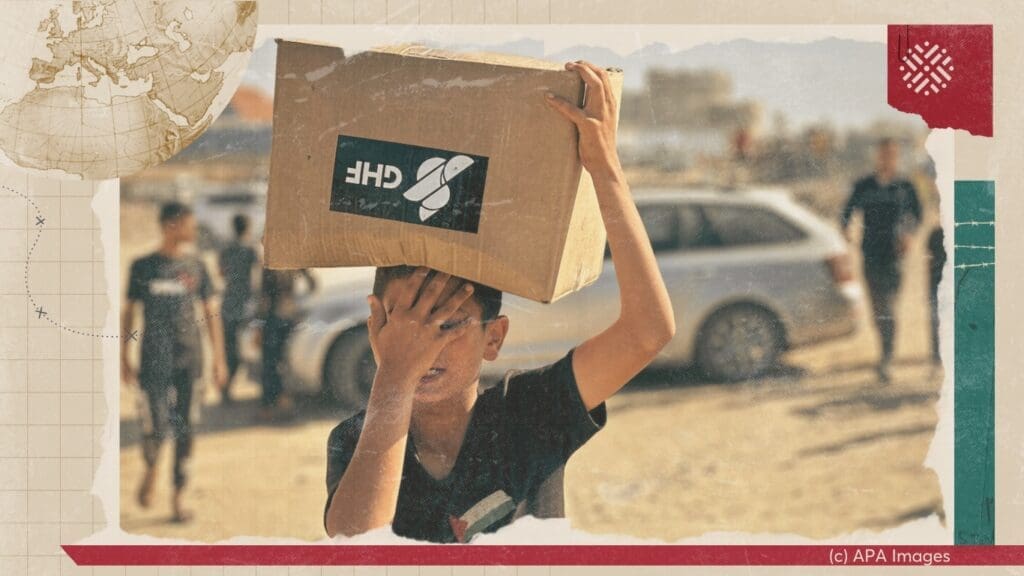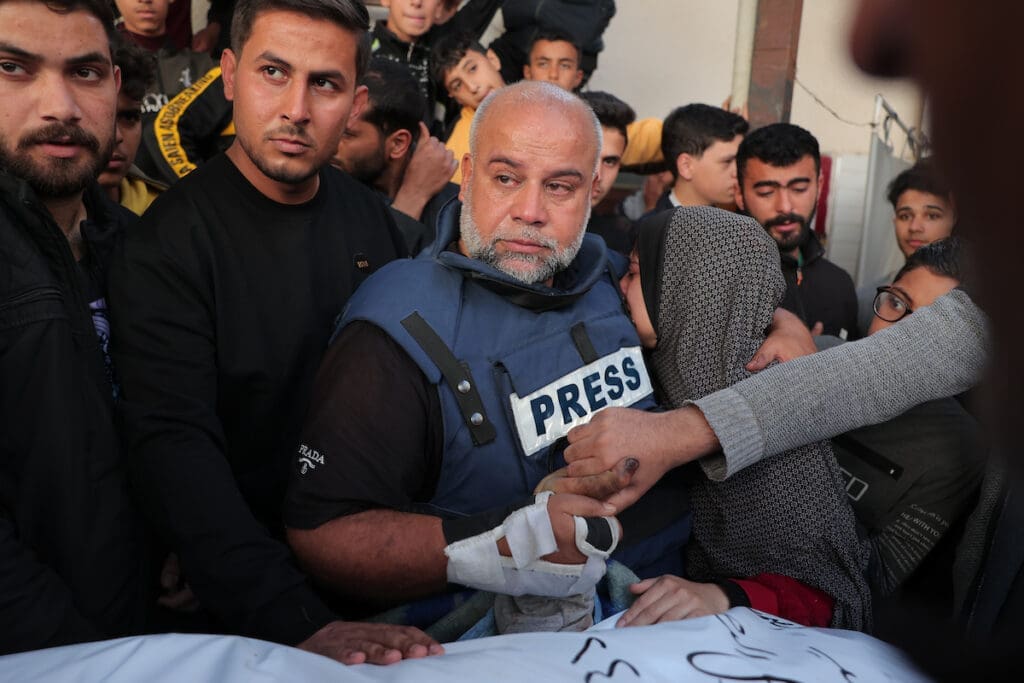- Topics
-
Topics
See our analysis on civil society and how it shapes culture, politics, and policies
Read our insights on the shifting political landscape and what it means for Palestine
Learn more about the policies and practices shaping the Palestinian economy
Strengthen your understanding of the unique conditions for Palestinian refugees across the Middle East
-
- Analysis
-
Analysis
In-depth analysis on existing or potential policies that impact possibilities for Palestinian liberation.
Insights and perspectives on social, political, and economic questions related to Palestine and Palestinians globally.
Concise analysis into a specific policy, its background and implications.
Commentary that brings together insights from multiple analysts.
Compilations of past Al-Shabaka works surrounding a specific theme.
Longer-form, ad hoc projects that seek to confront research questions outside the scope of our regular analysis.
A policy-driven research initiative by Al-Shabaka: The Palestinian Policy Network.
Our monthly webinar series that brings together Palestinian experts.
Featured
On Thursday, June 19, 2025, Israeli Prime Minister Benjamin Netanyahu stood in front of the aftermath of an Iranian strike near Bir al-Saba’ and told journalists: “It really reminds me of the British people during the Blitz. We are going through a Blitz.” The Blitz refers to the sustained bombing campaign carried out by Nazi Germany against the UK, particularly London, between September 1940 and May 1941. With this dramatic comparison, Netanyahu sought to elicit Western sympathy and secure unconditional support for his government’s latest act of military escalation and violation of international law: the unprovoked bombing of Iran. This rhetorical move is far from new; it has become an enduring trope in Israeli political discourse—one that casts Israel as the perennial victim and frames its opponents as modern-day Nazis. Netanyahu has long harbored ambitions of striking Iran with direct US support, but timing has always been central. This moment, then, should not be viewed merely as opportunistic aggression, but as part of a broader, calculated strategy. His actions are shaped by a convergence of unprecedented impunity, shifting regional dynamics, and deepening domestic political fragility. This commentary examines the latest escalation in that context and discusses the broader political forces driving it. Yara Hawari· Jun 26, 2025Launched on May 26, 2025, and secured by US private contractors, the new Israeli-backed aid distribution system in Gaza has resulted in over 100 Palestinian deaths, as civilians navigated dangerous conditions at hubs positioned near military outposts along the Rafah border. These fatalities raise grave concerns about the safety of the aid model and the role of US contractors operating under Israeli oversight. This policy memo argues that the privatization of aid and security in Gaza violates humanitarian norms by turning aid into a tool of control, ethnic cleansing, and colonization. It threatens Palestinian life by conditioning life-saving aid, facilitating forced displacement, and shielding the Israeli regime from legal and moral responsibility. It additionally erodes local and international institutions, especially UNRWA, which has been working in Gaza for decades.
Yara Hawari· Jun 26, 2025Launched on May 26, 2025, and secured by US private contractors, the new Israeli-backed aid distribution system in Gaza has resulted in over 100 Palestinian deaths, as civilians navigated dangerous conditions at hubs positioned near military outposts along the Rafah border. These fatalities raise grave concerns about the safety of the aid model and the role of US contractors operating under Israeli oversight. This policy memo argues that the privatization of aid and security in Gaza violates humanitarian norms by turning aid into a tool of control, ethnic cleansing, and colonization. It threatens Palestinian life by conditioning life-saving aid, facilitating forced displacement, and shielding the Israeli regime from legal and moral responsibility. It additionally erodes local and international institutions, especially UNRWA, which has been working in Gaza for decades. Safa Joudeh· Jun 10, 2025In this policy lab, Mariam Barghouti and Sharif Abdel Kouddous join host Tariq Kenney-Shawa to discuss Israel’s targeted assassination campaign against Palestinian journalists, the complicity of Western media in normalizing these crimes, and how this silence allows Israel to get away with genocide.
Safa Joudeh· Jun 10, 2025In this policy lab, Mariam Barghouti and Sharif Abdel Kouddous join host Tariq Kenney-Shawa to discuss Israel’s targeted assassination campaign against Palestinian journalists, the complicity of Western media in normalizing these crimes, and how this silence allows Israel to get away with genocide. Mariam Barghouti· May 28, 2025
Mariam Barghouti· May 28, 2025
-
- Resources
- Media & Outreach
- The Network




Restructuring the Palestinian Authority: It’s Now or Never
Overview
The Palestinian Authority (PA) has perhaps never been so embattled, polarizing, or internally fragmented.
In the Occupied Palestinian Territory (OPT), the PA has cut itself off from Gaza, and reconciliation between Hamas and Fatah continues to be elusive. Regionally, the PA has never been as alienated from its Arab allies. New leadership in key states, such as Saudi Arabia, eager to kowtow to the Trump Administration and find common ground with Israel on the issue of Iran, has led to disastrous shifts in Arab policy and discourse on Palestine. The rush to normalize with Israel is on, emboldening the Israeli occupation forces. Increased repression in these normalizing states also means a near systematic state-level campaign of repression aimed at curtailing pro-Palestinian voices.12
Internationally, the rise of right-wing fascistic elements in a number of countries has narrowed the opportunities available to the PA to apply pressure on Israel. Moreover, the frequent charge of anti-Semitism, so often a disingenuous red herring, has become a useful tool to silence voices of opposition regarding the Israeli occupation, leading to unprecedented attacks on free speech and freedom of assembly in the US, UK, Germany, and elsewhere. Thus, even though the Israeli occupation is increasingly unpopular amongst the public, “lawfare” strategies have had the effect of chilling activism on Palestine, including sometimes successful attempts at passing anti-BDS legislation.
Most important in these current conditions is the further rightward shift of the US in regard to Israel-Palestine, with Donald Trump and his son-in-law, Jared Kushner, at the reins. Together they have decimated international institutions and allowed Israel to behave with even more impunity than it had enjoyed previously.
As such assaults on Palestinians intensify, the PA finds itself losing key reservoirs of support. Yet in the face of these myriad challenges, the PA has not sought to repair or strengthen relations with its own people or those who advocate for them. Rather, it has become increasingly authoritarian, to the detriment of Palestinians and their relationship with those claiming to represent them.
Though the PA may continue to operate and be recognized as the de facto authority in the occupied West Bank despite the local, regional, and international geopolitical transformations described above, as this state of affairs continues it may lose all relevance in the negotiation process and as a representative of the Palestinian people.
This commentary first discusses the disconnect between the PA and the Palestinian citizens under its control. It then examines how international involvement, in particular increasingly harmful US policy, has helped to shore up this disconnect, as such involvement has rendered the PA progressively repressive and divisive. This has made political activism in the OPT more difficult.
However, while the PA is at a critical and daunting juncture, this moment can be used to restructure state-society relations between the PA and Palestinians, both in the OPT and the diaspora. Palestinian civil society also has the chance to unify in its fight against both the occupation and the harmful PA leadership. Unless such developments occur, dynamics of stagnation and futile politics will likely continue.
The Political-Societal Disconnect
It is clear that the PA has no coherent strategy at this point, often only reacting in response to changes in Israeli or American policy. The PA’s repeated threats of severing ties and security coordination with Israel have never materialized, with the effect that such threats are no longer given credence or credibility.
The continuing reign of the “old guard” within Fatah, as opposed to the “new guard” – and the ensuing division in the party – helps ensure this lack of strategy. Although there have always been lines of division within Fatah it had attained a reputation as the one faction with no barriers to entry under Yasser Arafat’s leadership, and was thus considered the more representative and inclusive of the factions, with an attendant impression of an internal unity. This is not to imply that Fatah did not face tensions during critical times, such as during the war of the camps in the 1980s. However, the party had an overall higher level of legitimacy amongst its members and wider Palestinian society.
Under Mahmoud Abbas, this is no longer the case. PLO institutions have become ever more irrelevant following the international sanctions imposed on the PA after the 2006 elections that brought Hamas to power. Fatah’s US-backed attempt to reverse the election results, successful in the West Bank, led to the severing of the West Bank and Gaza Strip and a de facto state of emergency in both parts of the OPT. This continues to be the backdrop to Abbas’s long-expired presidential reign, one he seems intent to overstay indefinitely. Attempts by the “new guard” to engage with Fatah institutions and reevaluate leadership, such as through the party’s Sixth and Seventh General Congresses, have failed.
The divergence between the PA and the Palestinian public is partly due to the role of international involvement Share on XAs a result, Fatah and the PA face a legitimacy crisis amongst Palestinian society. In a recent poll, 80% of Palestinian respondents reported that they believe there is corruption in the PA, and close to 50% feel that the PA is a burden on the Palestinian people. Almost two thirds of those polled want Abbas to resign and are dissatisfied with his performance.
A divergence is also clear in the opinions and preferences of OPT Palestinians versus the opinions and preferences of their leadership. For example, while the PA took punitive measures against the Hamas regime in Gaza, cutting, for instance, electricity payments and government salaries, 82% of Palestinian respondents supported the removal of such measures.
In my forthcoming book, Polarized and Demobilized: Legacies of Authoritarianism in Palestine, I find further evidence of this divergence. When asked about democracy and accountability, those in the Palestinian leadership are quick to claim that their society is unsuitable for an accountable political system, despite the fact that 81% of Palestinian respondents in a nationally representative survey expressed that democracy and accountability are important.3
The Impact of International Intervention
This divergence between the PA and the Palestinian public is partly due to the role of international involvement, meaning targeted aid as well as forms of diplomatic and material pressures. These interventions incentivize the Palestinian leadership to disregard public opinion, as it is often at odds with the preferences of powerful donors such as the United States.
International involvement has taken a number of forms. First, in my research PA officials reported that the US imposes conditions on the content and types of training available to PA employees, particularly within the interior ministry, and that the US keeps Palestinian officials with a history of protest, dissenting views toward the US, or resistance against Israel out of these programs. I also found evidence of systematic and targeted use of forced retirements of such resistant figures during the US-supported rise of Salam Fayyad to power. Moreover, PA officials reported that the source of funding frequently did not matter, as US policies were often adopted by other donors. EU countries and others therefore follow suit on most US restrictions.
International involvement has also shifted elite perception and preferences at the individual level. During interviews with PA bureaucrats, all of them cited international involvement – and the threat of its destabilizing effects – as motivation for their insistence on continued PA policies, including arrests of opposition figures and security coordination with Israel. This was the case even for those in positions without direct contact with US officials and institutions.
Indeed, Palestinian officials have come to avoid any issues that might pose a threat to US positions and funding. PA bureaucrats often reported how backward and ill-suited Palestinian society is to democratic norms; after all, they would claim, Palestinians elected an Islamist party. These bureaucrats would also repeat talking points about the use of authoritarian practices, namely that they are in the service of “stability” and therefore cannot count as “repression.” Further, PA officials referred to political opponents as “terrorists,” an echo of American counter-terrorism policy and rhetoric following the George W. Bush Administration.
The PA can either try to restructure its objectives and relationship to Palestinian society, or it can remain stagnant and reactive and stumble into further failure Share on XIn contrast, Palestinian survey respondents who were not connected to the PA through employment were not motivated by international involvement. Specifically, priming survey respondents with information on instances of international intervention did not affect the answers of those unconnected to the PA. It did, however, affect the responses of those who reported employment with the PA or its affiliate institutions.
Respondents affiliated with the PA, when reminded of international involvement in the Arab world related to so-called democratization efforts, were less likely to report that democracy and accountability were important to them. International involvement – even the type that is supposedly pro-democracy – was equated with hypocrisy and instability by these respondents. Hence, not only is international involvement causing a divergence between Palestinian leadership and the public, but among the public itself.
A Fragmented Civil Society
Due to the PA’s authoritarian strategies and practices, as well as the deep schism between Gaza and the West Bank, Palestinian society today suffers from a lack of viable leadership and an overall sense of disunity. Targeted PA repression of certain civil society groups has led to almost insurmountable grievances among these groups as a whole, and has increased insularity, making groups less likely to work together or achieve a critical mass of support.
For instance, in my research, leftist activists complained that the PA often targets them for their activities, or attempts to control their agenda and strategies. These groups were subsequently inhibited in their ability to reach out to anyone beyond their immediate circles. To engage in political action, they had to make sure it did not get the attention of authorities. This strategy is intended to circumvent repression, but it also significantly reduces activists’ capacity for large-scale collective action.
Similarly, amongst popular committees in the villages surveyed, activists complained of PA intrusion and cooptation strategies. For example, in the village of Bil’in, northwest of Ramallah, a committee formed to protest the Separation Wall that took a large portion of the village’s land. The committee brought together villagers regardless of political background, and was intentionally organized outside of the PA’s institutions (such as via the local village council).
Activists reported that the PA would often send representatives to the Bil’in protests to “legitimize” them, but in exchange it made clear that the protests should only be held in Area B and that the protestors’ demands were confined to specific asks related to the wall. This occurred despite the fact that villagers repeatedly articulated their refusal of the status quo, including the dynamic of PA-Israeli cooperation. Moreover, the PA worked to incorporate villagers as employees in PA-affiliated organizations, thus shifting the locus of organizing from the village to Ramallah. These PA strategies weakened the movement over time.
Furthermore, surveys of Birzeit University students of various political affiliations showed that PA repression renders students affiliated with Islamist politics/parties less likely to work with other students on issues of common interest. PA repression particularly polarized students affiliated with Islamist politics/parties and those affiliated with leftist politics/parties. Consequently, these two groups became more entrenched in their ideas and less willing to cooperate across political divides. PA repression does not have the same effect on students affiliated with Fatah, who for obvious reasons do not feel particularly under attack by the government.
PA repression has therefore impacted groups that view themselves as the most targeted or vulnerable. Such repression has a direct effect on these groups’ willingness to work with others across political lines. PA policies and actions have thus effectively limited collective action in the territories overall.
Documentation of protests from 2007 to 2016 that I gathered further demonstrates that mobilizations occur more often in areas that are not under direct PA control. Although many more Palestinians live in Area A compared to Area B or C, the data shows that protest is inhibited in Area A but on the rise in Area B and Area C in a way that is incommensurate with the population numbers.
If the PA does not behave as a complicating factor and a hindrance, Palestinian activism is likely to be much more effective Share on XSome protest movements exemplify this trend, such as those that have emerged in short bursts in places like Jerusalem, where Israel has prohibited any official PA functioning. In these areas, protest is more likely to emerge at critical times, though they are often unsustainable, as they are leaderless and impromptu. In many of these places, and particularly in Jerusalem, the Israeli occupation has effectively destroyed Palestinian institutions that have historically served as vehicles for organizing. As a result, when situations arise that require a Palestinian response, protests spontaneously emerge to meet short-term objectives but cannot continue.
One example of this trend is the protests that erupted regarding restrictions on the Al-Aqsa compound in July 2017: These were quick to emerge, focused on specific objectives, succeeded to some degree, and quickly dissipated. The possibility of turning such mobilization efforts into longer-lasting campaigns is limited due to Israeli repression. And, in areas where Palestinians have (theoretically) more freedom of movement, the PA has had the effect of chilling collective action altogether.
What Can Be Done?
Palestinian leadership
So far, the PA has resisted pressure to engage in harmful initiatives such as the Jared Kushner-led “Peace to Prosperity” conference held in Bahrain, or to forego payments to families of martyrs. Yet reactive positions are not enough. The silver lining of the Trump Administration’s complete disregard of international law and past peace process agreements is that the PA has the chance to restructure state-society relations for the first time in many years. US funding has already been cut, and attacks on the PA from the US and its allies have quickly destroyed any kind of bargaining power the PA might have had on the international stage. As such, in terms of the negotiation process, the Palestinian leadership has nothing to lose.
Instead of merely reacting, the PA can use this opportunity to reorient its objectives and rebuild ties with Palestinian society. This means bringing to the table Palestinian political parties that were sidelined as a result of American and Israeli involvement, including Islamist groups. Fatah and Hamas must take reconciliation efforts seriously. This also means utilizing the PLO as an institution, and revitalizing it once again so as to activate parts of the Palestinian diaspora that have remained neglected.
The PLO was effectively hollowed out as an institution and liberation movement as a result of the Oslo Accords, and has been superseded by the state-building project of the PA. But to create more space for Palestinian leadership and to harness parts of Palestinian society that are not just in the West Bank, it is imperative that the PLO is revitalized in a meaningful way. The last Palestinian National Council (PNC) appointments and meeting, by all accounts, did not achieve this objective. A call for meaningful elections – and not just of the PNC – could therefore be a good place to start, as well as the incorporation of Islamist parties into the PLO. This must include the Palestinian Legislative Council and the office of the president.
The PA leadership can do all this without fearing consequences from the US – after all, Trump has already ceded Jerusalem to the Israelis, and his administration has implicitly approved the idea of outright annexation of the West Bank. It truly is a now or never moment: The PA can either try to restructure its objectives and relationship to Palestinian society, and as such regain its relevance, or it can remain stagnant and reactive and stumble into further failure.
Palestinian civil society
Concurrently, Palestinian civil society needs to understand the impact of 25 years of the PA, particularly the repercussions of targeted repression and increased grievances among groups. Understanding this dynamic is the first step to combating its effects. Palestinian activists can begin to rebuild ties with each other and across political divides, and recognize that the polarization that now exists can be resolved. Taking lessons from research on mobilization, as well as their own experiences of mobilization, can help to mount effective challenges to the Israeli occupation.
This means developing new vehicles for collective action that are representative of the various political movements that exist in Palestinian society, without exclusions. For example, BDS has served as a useful model because it incorporates Palestinians regardless of political belief and unites them over shared objectives.
Similarly, the protest movements that have emerged in villages, such as in Bil’in, have incorporated Palestinians of different political affiliations over shared goals. In some places, popular committees are being revived for this purpose. Of course, the challenges of organizing under occupation should not be underestimated, especially as Israeli repression fiercely attempts to subdue any possible challenge.
However, Palestinian civil society has found creative ways to organize in the past, using professional organizations, neighborhood popular committees, and more. If the PA does not behave as a complicating factor and a hindrance, such as in the cases of village mobilization highlighted above, Palestinian activism is likely to be much more effective.
The atomization of Palestinian civil society must end in order for the Palestinian people to effectively challenge the status quo. With a more unified front, not only will Palestinians be more capable of challenging the occupation, they will also demand greater accountability from their leaders.
Dana El Kurd
Latest Analysis
Timed for Impunity: Israel’s War on Iran
Outsourcing Occupation: US Private Contractors in Gaza
Israel’s War on Palestinian Journalists
We’re building a network for liberation.
As the only global Palestinian think tank, we’re working hard to respond to rapid developments affecting Palestinians, while remaining committed to shedding light on issues that may otherwise be overlooked.